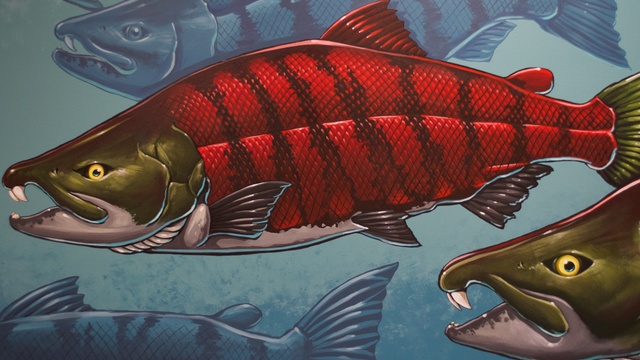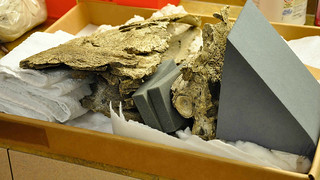
A sabertooth salmon, as depicted by artist Ray Troll. The mural is part of the UO Museum of Natural and Cultural History. | credit: University of Oregon.
Amelia Templeton, Earth Fix
For years, museum conservators and paleontologists have yearned for a way to duplicate fragile fossils without damaging them. Now scientists with the University of Oregon say they have found a way to do just that, with the help of a relatively inexpensive 3-D printer.
They’ve starting by duplicating the skull of a particularly important fossil in their collection: a giant saber-toothed salmon fossil discovered near Madras, Ore.
Nick Famoso, a PhD student at the university, is helping with the replication process. He says saber-toothed salmon, Oncorhynchus Rastrosus, swam the oceans and rivers of the Northwest 5 to 7 million years ago. They were ancestors of sockeye salmon.
“Put a big old gnarly tooth in the front jaw. Make it a lot bigger. That’s a saber-tooth salmon,“ he says.
The salmon grew to be 6- to 12-feet long, on a vegetarian diet of plankton and filter food. The tooth, which grew as long as a human thumb, developed on spawning males.
Famoso says the university holds what’s known as a “type specimen” of Oncorhynchus: a particularly well-preserved example that was used to describe the species. The university wanted to make the fossil the centerpiece of a salmon evolution exhibit at its Museum of Cultural and Natural History. But the Oncorhynchus fossil was too fragile and too scientifically valuable to risk casting — using the traditional method of pouring a latex mold around the fossil.
Famoso says delicate fossils of fish and bird skeletons can shatter and be permanently lost during the process of removing the mold.
“Generally when you do that we use latex and we make molds, and we pull the mold and we make a cast out of that mold. That’s great but not all fossils can be molded and cast. This is where the 3-D printing comes in and it’s really exciting.”
Instead, the salmon fossil was given a CT scan, creating a detailed 3-D image. Now the university’s science librarian, Dean Walton, is feeding that image file into a 3-D printer. The printer’s software slices the image into a series of thin layers that are laid down with a plastic called polylactic acid.
“In some ways, you can think of this as a glorified glue-gun that’s melting and squirting out a little line of plastic,” he says.
Walton says the printer, which cost a little over $2,000, can print objects the size of a milk carton and has a resolution down to a tenth of a millimeter. He says University of Oregon students and faculty can use the printer for free, but should be warned it’s a slow process. Printing the first piece of the salmon fossil took 72 hours.
Walton is printing several more segments of the fossil this month. When it is complete, Famoso will use the plastic replica to make a traditional cast model for display. He hopes the new replication technology will make it easier for scientists to share copies of fossils for research and public display without putting the originals at risk. He says Badlands National Park in South Dakota is also experimenting with the technique. Paleontologists at the University of Washington are using a 3-D printer to make custom cradles to securely hold delicate fossils in place.
The replica of the saber-toothed salmon fossil will go on display at University of Oregon’s Museum of Natural and Cultural History this year.


